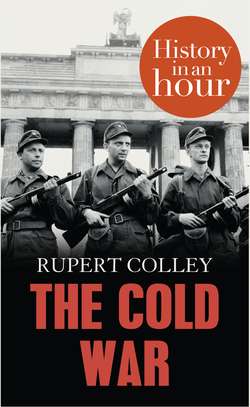Читать книгу The Cold War: History in an Hour - Rupert Colley - Страница 9
ОглавлениеThe Marshall Plan: ‘Communism cannot be stopped in Europe’
Three months after Truman’s speech, the offer of US aid was extended to any European nation that needed it. This aid package, the European Recovery Program, more commonly known as the Marshall Plan after its originator George C. Marshall (pictured below), aimed to revive Europe’s post-war economies, to alleviate hardship, and to deprive communism of its foothold. Once these economies were stabilized, the theory went, the US, too, would benefit, as trade between Europe and the US increased.
George C. Marshall
The offer was extended to the countries of eastern Europe and the Soviet Union itself. The Soviet Union had received huge loans from the US during the war to help defeat Germany and now, during the immediate post-war years, further aid would have been hugely beneficial to a country still suffering economically from the consequences of its war effort. But Stalin was never going to allow US/capitalist interference within the Soviet economy, and nor would he permit it in his satellite states. However, Poland and Czechoslovakia, still at this stage a democracy, saw the obvious benefits of US aid, and both accepted invitations to attend a conference in Paris, set for July 1947, to discuss the Marshall Plan. Furious, Stalin forbade them to go. Meekly, representatives of the Polish and Czechoslovakian governments traipsed to Moscow to face their dressing-down from Stalin, and returned home to politely decline the invitation to Paris. By February the following year, Czechoslovakia’s communists staged a coup overthrowing the only democratic government in eastern Europe, replacing it with a communist regime loyal to Stalin and Moscow.
In April 1948, Italy went to the polls. The US Congress was worried: ‘If Italy goes red, communism cannot be stopped in Europe’, and threatened to prohibit Italy from receiving Marshall aid if the communists won. They did not. The Marshall Plan, therefore, had the effect of reaffirming Churchill’s concept of the Iron Curtain by forcing countries to decide whether their loyalties lay to the west or the east. Sixteen countries finally accepted aid, which by 1952, had amounted to $13 billion. For those who chose the west, Italy and Denmark for instance, economic assistance came hand in hand with military protection with, in April 1949, the formation of NATO (the North Atlantic Treaty Organization), initially signed by twelve countries. West Germany joined in 1955, the same year that the Soviet Union and her seven satellites, as a direct counterbalance to NATO, formed the Warsaw Pact.
